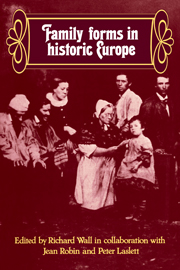Book contents
- Frontmatter
- Contents
- List of contributors
- Preface
- 1 Introduction
- 2 Two kinds of pre-industrial household formation system
- 3 ‘A large family: the peasant's greatest wealth’: serf households in Mishino, Russia, 1814–1858
- 4 The peasant family as an economic unit in the Polish feudal economy of the eighteenth century
- 5 The familial contexts of early childhood in Baltic serf society
- 6 Estonian households in the seventeenth and eighteenth centuries
- 7 Family and familia in early-medieval Bavaria
- 8 The property and kin relationships of retired farmers in northern and central Europe
- 9 Pre-industrial household structure in Hungary
- 10 The reconstruction of the family life course: theoretical problems and empirical results
- 11 The changing household: Austrian household structure from the seventeenth to the early twentieth century
- 12 Does owning real property influence the form of the household? An example from rural West Flanders
- 13 The evolving household: the case of Lampernisse, West Flanders
- 14 The composition of households in a population of 6 men to 10 women: south-east Bruges in 1814
- 15 The importance of women in an urban environment: the example of the Rheims household at the beginning of the Industrial Revolution
- 16 The household: demographic and economic change in England, 1650–1970
- 17 Family and household as work group and kin group: areas of traditional Europe compared
- References
- Index
11 - The changing household: Austrian household structure from the seventeenth to the early twentieth century
Published online by Cambridge University Press: 05 November 2011
- Frontmatter
- Contents
- List of contributors
- Preface
- 1 Introduction
- 2 Two kinds of pre-industrial household formation system
- 3 ‘A large family: the peasant's greatest wealth’: serf households in Mishino, Russia, 1814–1858
- 4 The peasant family as an economic unit in the Polish feudal economy of the eighteenth century
- 5 The familial contexts of early childhood in Baltic serf society
- 6 Estonian households in the seventeenth and eighteenth centuries
- 7 Family and familia in early-medieval Bavaria
- 8 The property and kin relationships of retired farmers in northern and central Europe
- 9 Pre-industrial household structure in Hungary
- 10 The reconstruction of the family life course: theoretical problems and empirical results
- 11 The changing household: Austrian household structure from the seventeenth to the early twentieth century
- 12 Does owning real property influence the form of the household? An example from rural West Flanders
- 13 The evolving household: the case of Lampernisse, West Flanders
- 14 The composition of households in a population of 6 men to 10 women: south-east Bruges in 1814
- 15 The importance of women in an urban environment: the example of the Rheims household at the beginning of the Industrial Revolution
- 16 The household: demographic and economic change in England, 1650–1970
- 17 Family and household as work group and kin group: areas of traditional Europe compared
- References
- Index
Summary
Introduction
Since Berkner drew attention in 1972 to Austria's then as yet untouched sources for the structure and history of the family, much work has been done by Austrian historians, and today one can fairly say that the main difficulties in studying family structures in Austria since 1600 are caused not by lack of sources but by the problem of coping with the great quantity of material available. It is, however, possible to give a broad outline of how work on this material has progressed and of the problems which have arisen.
One of the most interesting features of the Austrian sources is the series of annual Seelenbeschreibungen or libri status animarum, literally translated as ‘soul descriptions’. These are census lists with additional remarks on the religious and sometimes on the moral behaviour of the people. They may cover quite long periods, so that it is possible to follow domestic groups throughout their developmental cycle. Analysis of these lists have led us to definitions of ‘family’, ‘household’, and ‘houseful’ differing slightly from those propounded by Peter Laslett. Basically, we place the greatest importance on the social roles within the family and household, and prefer not to stress biological or purely matrimonial connections unduly. However, the authority of the head of the household and/or the spouse would seem to be a very important factor in binding different members of family and household together.
Looked at from this last point of view, there can be no clear distinction among family, household, and houseful, but only a gradual diminishing of authority outwards.
- Type
- Chapter
- Information
- Family Forms in Historic Europe , pp. 347 - 378Publisher: Cambridge University PressPrint publication year: 1983
- 8
- Cited by

